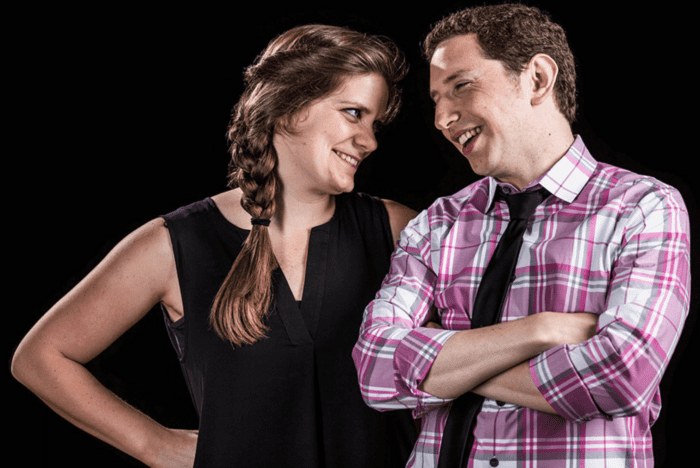 Relationships are hard to pull off in life and on the stage. So is comedy. Dating: Adults Embracing Failure (“DAEF”) is unfortunately only a superficial exploration of both. Although the premise is clever in its simplicity, the show fails both as a comedic venture and also as an examination of relationships.
Relationships are hard to pull off in life and on the stage. So is comedy. Dating: Adults Embracing Failure (“DAEF”) is unfortunately only a superficial exploration of both. Although the premise is clever in its simplicity, the show fails both as a comedic venture and also as an examination of relationships.
DAEF is a two-person show written by and starring Josh Lanzet and Lindy Voeltner. Together, they portray eight couples at various stages of their relationships. The underlying idea of the show is intriguing. In Ms. Voeltner’s own words, “what if we saw a couple at the very first meeting and then at their ending?”
This premise is reminiscent of the concept of “closure,” often employed in graphic novels. In his book, Understanding Comics, Scott McCloud defines closure as the phenomenon of observing parts of something and mentally completing what is incomplete based on past experiences. In the frames of a graphic novel, a reader may see two unconnected images, but closure allows the reader to fill in the gaps and “connect these moments and mentally construct a continuous, unified reality.”
In the same vein, DAEF gives us two vignettes, one at the beginning of a relationship, and one at the end. The audience implicitly fills in the intervening time. This is where the show falls short. For closure to work, the two snapshots of a relationship must be different. After all, entering into couplehood alters the dynamics between the people involved. For example, couples who have been together for a long time may develop a shorthand with each other. Or a man who is nervous and unsure of himself on a first date becomes more confident with his partner after three years of being together. And in the case of a relationship that lasts well beyond its expiration date, certain memories or topics could trigger intense emotional responses. But these types of changed dynamics rarely appear from one scene to the next.
Instead, in the world of DAEF, the couples in each vignette are underdeveloped stereotypes with stagnant lives and dynamics that do not evolve between their first meeting and their last. Each couple’s arc follows the same formula. When we meet them, one or both people have certain idiosyncrasies or obvious flaws that will predictably doom the relationship. The humor and any tension is deflated from the first scene because the audience can immediately spot why the pair does not work. The second scene depicting the end of the relationship becomes almost entirely superfluous as it rehashes the already apparent problems.
In one brief interaction, a man breaks up with a woman because he cannot deal with the way she sets too many alarms in the morning to wake up. The scene itself is cute and certainly relatable. The breakup is telling of the playwrights’ views on relationships. They’re easily disposable. That’s not necessarily a bad thing. Disposable relationships have the potential for great comedic effect, such as the inane reasons Jerry broke up with women in Seinfeld (e.g., for having “man hands;” for being a “low talker”). But the comedy is trite when overused and expected.
Here, the formula also does not ring true as far as relationships work. The couple who hated each other from the first date still hates each other three years later. And the characters lack the depth necessary to explain why they would have stayed together so long. Instead, we are given rather odd reasons why couples break up such as a woman finding out that her fiancé is gay, a misunderstanding between an elderly couple about what time to meet for tennis, and the convenient plot device of death. These reasons do not come across as personal for each couple, but rather as interchangeably plot devices that could just as easily have been used in any scene by any of the couples.
The show’s problems are exemplified in a scene where a woman and her future husband are sitting on a couch watching a movie. His first line of dialogue is the word “fabulous” with a nasal tone and high-pitched inflection. Soon after, the stage changes to a darkened police room where the woman interrogates her fiancé to determine if he is in fact a homosexual. The use of the interrogation room by the woman is amusing, but the content is extremely tone-deaf for the year 2015. She questions his sexuality because, among other reasons, he likes Restoration Hardware, design furniture, Celine Dion and Whitney Houston. But the scene takes a painfully cringe-worthy turn when he delivers a dramatic epiphanic monologue about his own sexuality – as if being confronted with a list of gay stereotypes, he can finally understand who he is as a person. The pair is later revisited in a flashback when the fiancé is asking the woman out for the first time and she is surprised because she thought he was gay. She agrees to go on a first date because he convinces her that his stereotypical gay attributes do not make him gay. But the earlier interrogation scene undermines this sentiment. I’ll give the playwrights the benefit of the doubt that that scene is more offensive because the humor is ineffective rather than intentionally promoting gay stereotypes. But the entire affair demonstrates that when you mix comedy and relationships indiscriminately, you can get unintended consequences.
Yet in light of the above, there is a lot of potential in a show like this. The playwrights are earnest and clearly had fun performing. But the performance could benefit from more subtle humor and character development.
